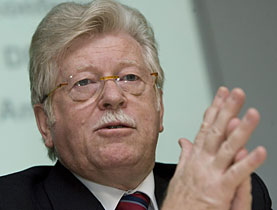Swiss aid experts face Mongolian challenge

Almost half of Mongolia is desert – and increasing. Switzerland, Mongolia's first non-socialist trading partner, is trying to stop this and save struggling herdsmen.
The Swiss Agency for Development and Cooperation (SDC) is focusing on the sustainable use and rehabilitation of natural resources.
“In the middle of August the pastures should be green so that the animals have enough to eat,” said Erdenbat, a father of two, pointing to the brown patch of land around his yurt.
“But even in summer there wasn’t enough grass – and then a poisonous weed grew that killed the animals. How are we going to survive the winter?”
This worry is shared by around 170,000 other shepherds in Mongolia, which has a total population of 2.65 million.
Outside the tent the sky is blue, sheep are bleating and snow-covered mountains line the horizon. But the idyllic image is deceptive: the mortality rate of the nomads’ lambs last year was 80 per cent, with this year expected to be little different.
The fields are overgrazed and eroded, and the washed out soil struggles to hold any water. The topsoil has been washed away and bushes and trees that would protect against wind and rain have been cut down.
Around 40 per cent of the country is now desert and heavy rains mean serious danger – floods at the end of July killed more than 20 people and made hundreds homeless.
Tragedy of the commons
“The blame for this desertification can’t be placed solely on climate change,” said Karl Schuler, an expert on the management of natural resources who is working in Mongolia on behalf of the SDC, which has been active in Mongolia since 2001 (see box).
“The shepherds are guilty to a great degree for the state of the pastures. They have too many animals. Under the Soviet system animals were nationalised and their number, some 25 million, were controlled across the country,” he told swissinfo.ch.
“Following the collapse of the Soviet Union there was no limit and the number of animals has doubled – the grasslands however have not grown.”
In addition there’s a lack of any form of pasture management. According to the Mongolian constitution, grazing land is common property – who looks after and uses it is not clearly defined. In a textbook example of what’s known as the tragedy of the commons, this results in not only overgrazing but also mismanagement.
The meat market is oversaturated and an export market doesn’t really exist – the quality of Mongolian meat doesn’t comply with international standards.
“Green Gold”
The SDC’s programme is intended to lead the nomads out of this vicious circle. In 2008 the organisation sent SFr8.62 million ($8.4 million) in bilateral development aid to Mongolia and SFr140,000 in humanitarian aid.
“The emphasis is on the sustainable use and rehabilitation of natural resources, and supporting environmentally friendly social and economic development in the country,” explained Felix Feldmann, the SDC’s head in Mongolia.
Work is being undertaken not only with herdsmen but also at a national level with authorities, focusing on a new pasture law.
In the SDC’s showcase “Green Gold” project, shepherds merge into so-called “pasture user groups”. In addition a management plan is being developed on how to use the pastures sustainably.
This includes looking after water sources, the gathering of hay for winter and the development of alternative sources of income, such as greenhouses to grow vegetables or sewing machines to make textiles.
The focus is on quality not quantity. The condition of the meadows and the number of animals should return to a level that is in balance with nature.
This process requires a lot of time, but it is essential: the United Nations fears that unless changes are made to how Mongolia uses its pastures, by 2050 about 70 per cent of the country will be desert.
Christa Wüthrich in Ulan Bator, swissinfo.ch (Adapted from German by Thomas Stephens)
Relations between Switzerland and Mongolia date back to the second half of the 1950s, when Zurich company Debrunner established trading relations with the People’s Republic of Mongolia.
Switzerland officially recognised the Democratic Republic of Mongolia on May 20 1964, though contacts between Bern and Ulan Bator remained modest until the socialist period came to an end.
Relations became closer from 1990, when democracy came to Mongolia. Economic contacts remain modest, though the number of Swiss tourists is rising.
Ethnic groups in Mongolia: 90% Mongolians, 10% Kazakhs
1.57 million km2 – Switzerland by comparison is just over 40,000km2.
Swiss colony: 32 persons
Gross domestic product (GDP): $3.16 billion
GDP per person: $1,216.18
Swiss exports: SFr 2.15 million
Swiss imports: SFr 2.29 million
(source: Swiss foreign ministry. Year not specified)
The Swiss Agency for Development and Cooperation (SDC) started activities in Mongolia in 2001 with aid measures in connection with the “zud” big-freeze disaster, following a joint appeal by the UN and the Mongolian government.
In 1999/2000, 2000/2001 and 2001/2002, Mongolia was hit by three zuds in a row, in which a total of 11 million animals were lost.
Since then, cooperation has gradually moved from humanitarian aid to development cooperation programmes. The SDC opened a cooperation office in Ulan Bator in 2004.
The goal of the SDC programme is to contribute to improving and providing more secure livelihoods for herders. Support is also provided for herders who have given up their nomadic way of life and moved to the cities.

In compliance with the JTI standards
More: SWI swissinfo.ch certified by the Journalism Trust Initiative













You can find an overview of ongoing debates with our journalists here . Please join us!
If you want to start a conversation about a topic raised in this article or want to report factual errors, email us at english@swissinfo.ch.